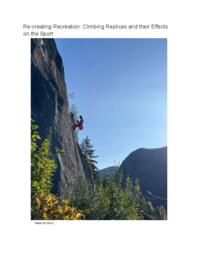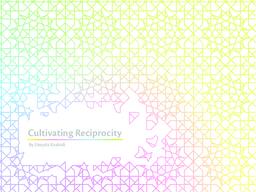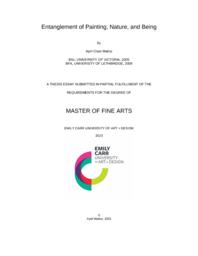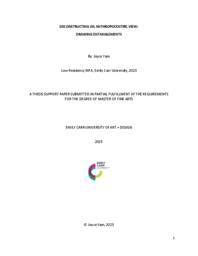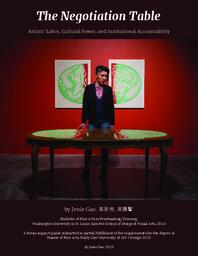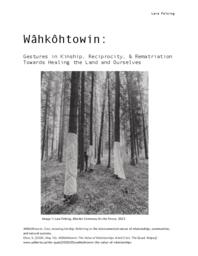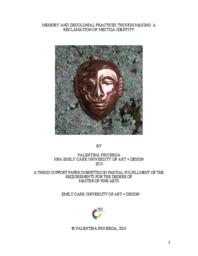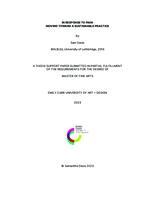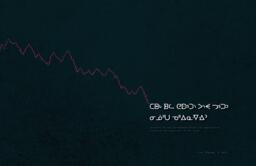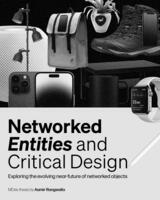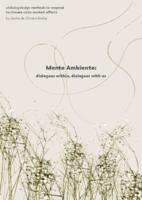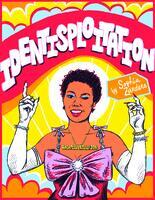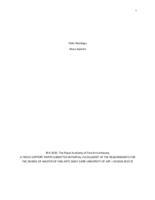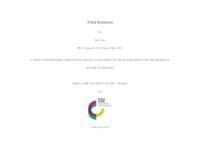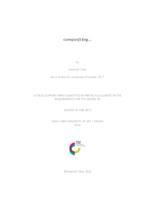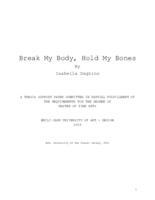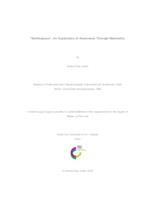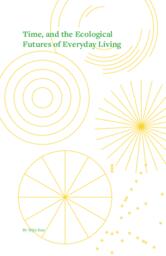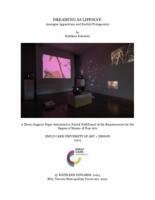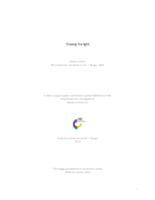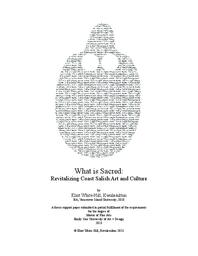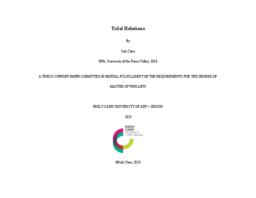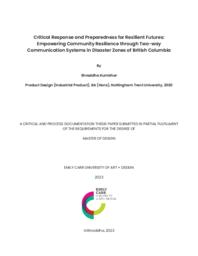Emily Carr University of Art and Design. Graduate Studies
Related Works
Content type
Digital Document
Origin Information
Content type
Digital Document
Origin Information
Content type
Digital Document
Origin Information
Content type
Digital Document
Origin Information
Content type
Digital Document
Origin Information
Content type
Compound Object
Description / Synopsis
This paper considers the role of an emergent embodied art practice in better understanding, communicating and managing the experiences of chronic illness and chronic pain. Referencing a history of pain scales, diagnostic tools, and pain management strategies that fail to provide adequate relief to those living with chronic conditions, this thesis illustrates the process I have taken to reconstruct my art practice which, built in tandem with intentional lived practices, has enabled me to inhabit my sick body in new ways. At an intersection between queer and chronic illness discourse, following an autotheoretical approach to making and writing, this project is built in deep connection to my own lived experiences. Life with chronic illness is shrouded with uncertainty and demands a practice that embraces the ebbs and flows, trial and errors, and desperate reaches directed by a wavering physical capacity. As such, I rely upon a network of actions that together build the foundation of my research praxis. Connecting my work to artists Janine Antoni, Zoe Leonard, Louise Bourgeois and Jo Spence, my thesis body of work weaves together drawing, photography, video, sculpture, digital collage, note-taking, dancing and walking as different modes of making. The residual artworks produced through these embodied practices work together to communicate my experience as an artist living with chronic illness. Concurrently, these practices offer themselves as maintenance, aiding in managing the symptoms of my physical condition and in the development of a sustainable art practice, re-imagined to work with the needs of my body rather than against it.
Origin Information
Content type
Digital Document
Origin Information
Content type
Digital Document
Origin Information
Content type
Compound Object
Description / Synopsis
Rapid technological advancements, tending toward an interconnected world automatized by communication between all networked objects, are gradually becoming the standard. This results in evolving human behaviours — technological artefacts emerge and the behaviour of technology towards humans shift. As these technologies become more prevalent in our surroundings, examining the ontological relationship between humans and user-centred networked technologies helps explore and understand the evolving concepts of agency and autonomy. With the rise of the Internet of Things (IoT), humans and smart, quantified, and generative technologies are becoming increasingly linked, co-evolving an interdependence of daily routines, behaviours, and sense of self. To offer a comprehensive view of our engagement with technology and to delve into the impact on daily human lives, a multidisciplinary approach, including Research Through Design, Critical design/making, Speculative Fictions, provocations, curatorial practices, observational writings, and performances were employed. A near-future video prototype employing design fiction (Bleecker, 2009), speculative approaches, and dramaturgy (Goffman, 1959) provides an engaging exploration of potential implications — also, consequences of increased connectivity and automation in our lives. The concept of “networked entities” is proposed as a valuable addition to the design methodology, situating the outcome in a plausible (Dunne and Raby, 2013) near-future. Networked entities that are conceived from the analysis of current behavioural patterns of a user are speculated to exhibit a heightened sense of agency and autonomy; this transforms passive objects in our lives into “active participants” (Bleecker, 2006). These objects adapt to our needs and preferences, making decisions on our behalf. This shift in the roles and capabilities cultivates discourse between relationships and expectations with technology and responsibilities with use. New perspectives on how to approach and understand the ontological relationship of humans and networked entities are explored to contribute to the broader conversation of the impact of this ever-present connection. Potential implications of increased connectivity and automation provides valuable insights for designers, policymakers, and users of technology as we move towards an increasingly interconnected world.
Origin Information
Content type
Compound Object
Description / Synopsis
This research addresses the affects experienced by most people in response to the current climate crisis. Research in the fields of psychology and human behaviour have termed the negative-value emotion “climate-anxiety.” My research inquires into both the positive and negative-value affects of this experience. To explore the nuances of this condition, the research is grounded in a practice-based methodology, using methods of speculative and participatory design. The personal explorations of narrative and future-building scenarios that express this condition are evidenced mainly through printmaking, embroidery, and writing. The learnings from these activities validate responses to climate destruction and validate the use of a creative practice to transition from value-negative to value-positive affects, allowing the self to reconcile with, and mediate these emotional responses. This research reveals a better understanding of the components of this condition and offers ways to moderate its experience in everyday life. It culminates in the rationalization of a model, Mente Ambiente, to better understand and navigate this condition. This is evidenced through a final project that engages with the model to guide a creative practice and reveal points of entry for others to explore the elements of their own condition.
Origin Information
Content type
Compound Object
Description / Synopsis
Identisploitation explores charged representations of identity in pop culture through painted paper figures, video art, and garments. The complicated public images of historical figures, including the iconic Black performer, Josephine Baker, are investigated, pulled apart, and recontextualized as exaggerated, lifesize paper dolls. Grotesque embodiments of evangelical, conservative American femininity are satirized through character performance in video. Historical costumes and unattainable beauty standards are stretched and sewn into unwearable garments. Identisploitation is influenced by the transgressive work of Vaginal Davis, Grace Jones, Bobby Conn and other fearless artists who inhabit the outskirts of the mainstream art world. The concepts of disidentification, the oppositional gaze, camp, and satire provide a critical and (pop) cultural framework, primarily through the texts of bell hooks and José Estéban Muñoz. Identisploitation asks these questions: What do pop cultural representations look like recontextualized through a Black feminist lens? How does a garment critique the cultural establishment? This thesis project explores historical representations of race, gender, and sexuality, and their lasting significance into contemporary visual language and pop culture through my particular point of view as a Black femme visual artist.
Origin Information
Content type
Compound Object
Description / Synopsis
This thesis document titled Palm Readings is informed by entangled topics that take up plein air painting, watercolour as a primary medium and the relationship of colour to the Caribbean island of Puerto Rico. The specific questions that I address in the work are: How can plein air painting in the Caribbean function as a form of deep acknowledgement of place? What is the potential of watercolour as a contemporary artistic medium? How can colour represent the Caribbean island of Puerto Rico and its culture? Each chapter of this thesis addresses these questions and is anchored by different visual examples of my Thesis Project. My research questions are informed predominately by visual research, observation and thinking through doing. While I do integrate various citations in this text, I am inspired predominantly by the physicality of experiential learning. My research occurs in the action of painting and what comes up in the process.
Origin Information
Content type
Compound Object
Description / Synopsis
This paper is the theoretical component that accompanies Sidi Chen’s Master of Fine Arts project, Tidal Relations, at Emily Carr University of Art + Design. Tidal Relations is a practice-based relational inquiry from the diasporic perspective of a queer Chinese person. Based on the artist's positionality, Chen concludes two key characteristics of Tidal Relations that are entanglement and trans-corporeality. While entanglement informs an interdisciplinary research methodology, trans-corporeality addresses intersubjectivity as a result of the kinesthetic empathy of bodies in Tidal Relations that are more than human. And to further orient and navigate the complexity of Tidal Relations, Chen interprets and utilizes the Chinese traditional philosophy, 留白, translated as to dwell in the blankness, as a relational principle and aesthetic strategy. Based on this principle, Chen explores the embodiment of Tidal Relations in three projects from their MFA studies: Where I Am When I Land Between the Waves, a contemporary experiment of traditional Chinese painting as a map of navigation; Pondering (Until It's Water on Both Sides), a site-specific performance drawn on locational scores and bodily fables as a way of knowing; and Mirage Raft (The dream talking Oyster), a multimedia performance installation that explores media as extensions of the body and measurement of diasporic distance.
Origin Information
Content type
Compound Object
Description / Synopsis
This writing is a window into my mind and the meandering thoughts behind a series of sculptural experiments and installations I have made from compostable materials. The work explores the porosity of bodies as entities and the symbiosis that becomes possible with permeability. Thinking through a critical discourse of ecologies, I (re)imagine and “propose near futures, possible futures, and implausible but real nows” through a materially emergent and ecological, situated practice (Haraway 2016, 136). I work with the embedded ideas by moving between 3 different lenses. I begin with Introweaving, my research as a network of pathways that a worm might meander through in a compost pile, opening the various spaces and materials that I use throughout my experiments. Bodies as microworlds probes notions of the body and its porous boundaries; ingesting and regurgitating become critical and generative metaphors for processing ingestible biomaterials made from food refuse. In/Between embraces the active process of borrowing and mutating processes and methodologies from distinct spaces and bodies of knowledge. (Un)Becoming zooms outwards to the cyclical aspects of life and time – exploring animacy, decay and regeneration as expressive processes. Complementing the initial Introweaving is a final section Interleaving, where I pause and gesture towards future experiments. I view this project and thinking as a become-with (ref. symbiosis/ the more-than-human/ land) is an ongoing process. These ideas are need to continuously percolating… my writing and my project are eternally compos(t)ing…
Origin Information
Content type
Compound Object
Description / Synopsis
My research takes place in my hometown, the rural community of Hope, B.C.. situated on the traditional territory of Chawathil First Nation and the Tiyt Tribe. The Tiyt Tribes of the Stó:lō territory extend along the boundaries down both sides of the Fraser River. Throughout my time at Emily Carr University of Art + Design I have engaged with many forms of research, using my lens to look at the complex history of Hope and its settler identity that is so deeply tethered to forms of extraction colonialism and white supremacy. Using anti-colonial and Indigenous/Intersectional Feminist theory as well as forms of lived experience rooted in coming of age and punk ethos to unpack the questions; “How does extraction colonialism impact community? and How do we form kinship in spite of embedded forms of white supremacy?” Through experimental filmmaking and analog photography, I work in a coming-of-age framework to examine what it means to grow up in a place tethered to active forms of extraction and colonial narratives.
Origin Information
Content type
Compound Object
Description / Synopsis
This thesis is a reflection on my artistic practice before and after the MFA program. While I initially thought it was about nothing, I later came to realize it was actually about "nothingness". I explored anamnesis, involuntary memory and the female body through an experiential approach using materials such as concrete, textiles and beeswax. Each work I created, raised new questions leading me to recognize alternative motives that were initially hidden but present in my body. It is a meditation on my artistic research and the richness that comes from embracing the unknown, uncertainty and wonder through my specific perspective as a female from Mexico.
Origin Information
Content type
Digital Document
Origin Information
Content type
Compound Object
Description / Synopsis
Edwards, Kathleen. DREAMING AS LIFEWAY: Analogue Apparitions and Earthly Protagonists. Master of Fine Arts, April, 2023, Emily Carr University of Art + Design, Vancouver, British Columbia, Canada. Shé:kon, sewakwé:kon. KJ ní’i. I am a Kanien’kehá:ka and mixed settler filmmaker, writer and video editor. My maternal family are wolf clan, Goodleafs, from Kahnawá:ke, Québec; and my paternal family is Edwards from Longueuil, Québec. My parents met in Montréal and both became educators. They traveled around the north teaching, eventually deciding to stay awhile in Treaty 6 Territory, Edmonton, Alberta, where I was born and raised. Skennen’kó:wa ken? This translates to: “Do you carry the Great Peace with you?” This is the Mohawk way of asking how someone is. And it is emblematic of the relational beauty of my maternal language, Kanien’kéha. An everyday greeting that is meaningful and rooted in one’s experience of the world through the spiritual. As I get older and continue to redefine my value system and further develop my practice, I aim to bring this kind of relational approach into my filmmaking process. By working with analogue film and engaging with different creative cohorts, I have realized that my work thrives because of the generosity of others and through knowledge exchange. My analogue practice is possible because of those who have mentored me and inspired me. My research looks to dreams as a lifeway, as a means to communicate with ancestors and to work creatively to tell stories, along with accessing memory and ideating. I reflect on the unpredictability of analogue workflows through eco processing 16mm film, looking to the medium as that of a collaborator. I inquire about the ways in which my particular neurodivergence and training might be both challenged and enriched through material processes, returning to an attentiveness of mind and body through the work and through these collaborations. Niá:wen, thank you for taking the time to engage with this writing.
Origin Information
Content type
Compound Object
Description / Synopsis
The thesis titled Chasing the Light, delves into the experience of art through a phenomenological approach to painting. By examining the relationship between painting, embodied experiences, and the built environment, the artist incorporates the concept of the expanded field of painting into her practice, creating site-adjusted installations that utilize light, temperature, and traditional painting tactics to elicit an immersive experience. Through the progression of her research and artistic output, the thesis demonstrates how lighting conditions can shape the perception of an installation and lead to a haptic, retinal, temperature, and atmospheric shift in the viewer's experience. The goal is to understand the relationship between the viewer, the artwork, and the environment, and how this relationship can be used to create a more meaningful and impactful experience for the viewer.
Origin Information
Content type
Digital Document
Origin Information
Content type
Digital Document
Origin Information

